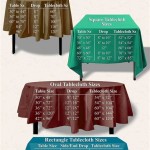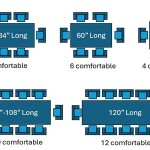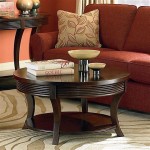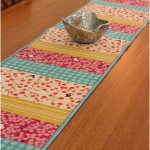How To Make A Macrame Table Runner
Macrame, the art of knotting cords or strings to create decorative patterns, has experienced a resurgence in popularity. One particularly appealing project for both beginners and experienced crafters is the creation of a macrame table runner. A macrame table runner adds a touch of bohemian elegance and texture to any dining or living space. This article provides a comprehensive guide to crafting a visually appealing and durable macrame table runner.
Materials and Tools Required
The successful completion of a macrame table runner requires careful selection of materials and tools. Choosing the appropriate materials ensures the finished product is aesthetically pleasing and structurally sound. The following is a list of essential items:
*Macrame Cord:
The type and thickness of the cord will significantly impact the final look and feel of the table runner. Cotton cord is a popular choice due to its softness, durability, and availability in various colors and thicknesses. Other options include jute, hemp, or synthetic cords. For a larger, more textured runner, a thicker cord (4-5mm) is recommended. For a more delicate look, a thinner cord (2-3mm) may be preferable. Calculate the required cord length based on the desired length of the table runner and the complexity of the knotting pattern. A general rule of thumb is to multiply the desired length by at least four to account for the cord consumed in the knots. *Measuring Tape:
Accurate measurements are crucial for ensuring the table runner is the desired length and width. A measuring tape provides the necessary precision. *Scissors:
Sharp scissors are essential for cleanly cutting the cords and trimming any stray ends. *Mounting Surface:
A stable mounting surface is needed to anchor the cords while knotting. Options include a macrame board, a curtain rod, a sturdy table edge, or a piece of dowel rod suspended between two chairs. *T-Pins (Optional):
T-pins can be used to secure the knots to the mounting surface, preventing them from shifting while working. This is particularly helpful for complex patterns. *Comb or Brush (Optional):
A comb or brush can be used to untangle and fluff the fringe at the ends of the table runner. *Liquid Fabric Stiffener (Optional):
If desired, a liquid fabric stiffener can be applied to the ends of the fringe to give it a more defined shape.Basic Macrame Knots
Mastering the basic macrame knots is fundamental to creating a successful table runner. The following are descriptions of two essential knots:
*Lark's Head Knot:
This knot is used to attach the cords to the mounting surface. To create a Lark's Head Knot, fold a cord in half, creating a loop. Place the loop behind the mounting surface (e.g., dowel rod). Bring the two ends of the cord through the loop and pull tight. This creates a secure attachment point. *Square Knot:
The Square Knot is a fundamental knot used in many macrame projects. It is created using four cords. Take the left cord (cord 1) and bring it over the two middle cords (cords 2 and 3) and under the right cord (cord 4). Then, take the right cord (cord 4) and bring it under the two middle cords (cords 2 and 3) and over the left cord (cord 1). Pull all four cords tight to form the first half of the Square Knot. To complete the Square Knot, repeat the process in reverse. Take the right cord (now cord 4) and bring it over the two middle cords (cords 2 and 3) and under the left cord (now cord 1). Then, take the left cord (now cord 1) and bring it under the two middle cords (cords 2 and 3) and over the right cord (now cord 4). Pull all four cords tight. This completes one Square Knot. Ensure the knots are consistently tightened to create a uniform look. *Half Square Knot Spiral:
This knot, also known as a spiral knot, is very similar to the square knot, but only uses half of the steps. Instead of alternating from each side like the square knot, you will simply tie the first half of the square knot repeatedly. As you repeat the process, the knot will naturally spiral.Step-by-Step Instructions for Creating a Macrame Table Runner
The following provides a detailed guide to creating a macrame table runner using Square Knots and variations. This design focuses on simplicity and elegance, making it suitable for beginners:
1.Prepare the Cords:
Measure and cut the macrame cord into the desired length. As previously mentioned, multiply the desired length of the table runner by at least four to account for the cord consumed in the knots. For a standard table runner, cords of 10-12 feet are generally sufficient. The number of cords needed will depend on the desired width of the table runner. A good starting point is to use 20-30 cords. 2.Attach the Cords to the Mounting Surface:
Using the Lark's Head Knot, attach each cord to the mounting surface. Ensure the cords are evenly spaced to create a uniform starting point. The number of Lark's Head Knots will determine the width of the table runner. 3.Start the First Row of Square Knots:
Divide the cords into groups of four. Using each group of four cords, tie a Square Knot. Ensure all the Square Knots in the first row are aligned and evenly spaced. T-pins can be used to secure the knots to the mounting surface, preventing them from shifting. 4.Create Subsequent Rows of Square Knots:
For the second row, shift the grouping of cords by two cords. This creates a staggered pattern. For example, instead of using cords 1-4, use cords 3-6 to tie the Square Knot. Continue this pattern for each subsequent row, creating a visually appealing design. 5.Vary the Knotting Pattern (Optional):
To add visual interest, consider incorporating variations in the knotting pattern. For example, use alternating Square Knots and Half Square Knot Spirals in different sections of the table runner. 6.Add a Border (Optional):
To create a decorative border, consider adding a row of Overhand Knots at the top and bottom of the table runner. An Overhand Knot is created by simply forming a loop with the cord and bringing the end of the cord through the loop. 7.Finishing the Table Runner:
Once the desired length is achieved, carefully remove the table runner from the mounting surface. Trim the ends of the cords to create a uniform fringe. A comb or brush can be used to untangle and fluff the fringe. 8.Apply Fabric Stiffener (Optional):
If desired, a liquid fabric stiffener can be applied to the ends of the fringe to give it a more defined shape. Follow the manufacturer's instructions for application. 9.Final Touches:
Inspect the table runner for any loose knots or stray ends. Trim any imperfections. Once the table runner is complete, it is ready to be displayed on a table.Creating a macrame table runner is a fulfilling and creative endeavor. By carefully selecting the appropriate materials, mastering the basic macrame knots, and following the step-by-step instructions, anyone can create a beautiful and unique piece of decor. The flexibility of macrame allows for endless customization, enabling crafters to design table runners that reflect their personal style and complement their home decor.

How To Make Macramé Table Runner Using 3 Simple Knots Macrame Tutorial

Make A Macrame Table Runner Tutorial The Diy Mommy

Diy Macrame Table Runner Craftgawker

Diy Macrame Table Runner Decoration Id Wall Hanging Patterns

Beginner Macrame Fringed Table Runner Diy Kimenink

How To Make A Macrame Table Runner Anthropologie Inspired The Diy Mommy

Diy Macrame Fringe Table Runner Driven By Decor

Hoooked Diy Macramé Kit Table Runner Caïro

Macrame Table Runner Boho Design Inspiration

Beginner Macrame Fringed Table Runner Diy Kimenink
Related Posts








